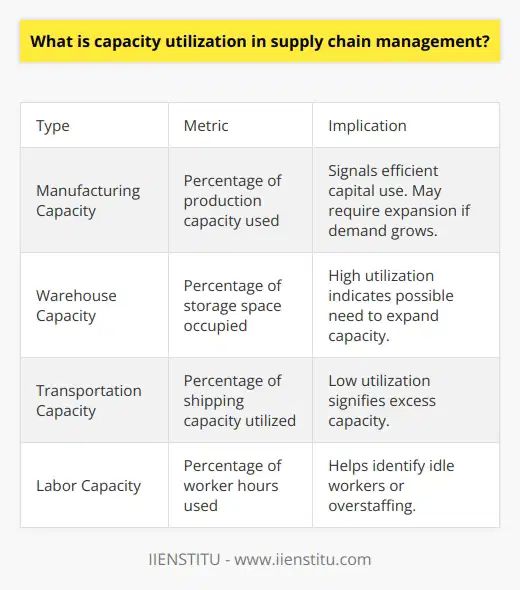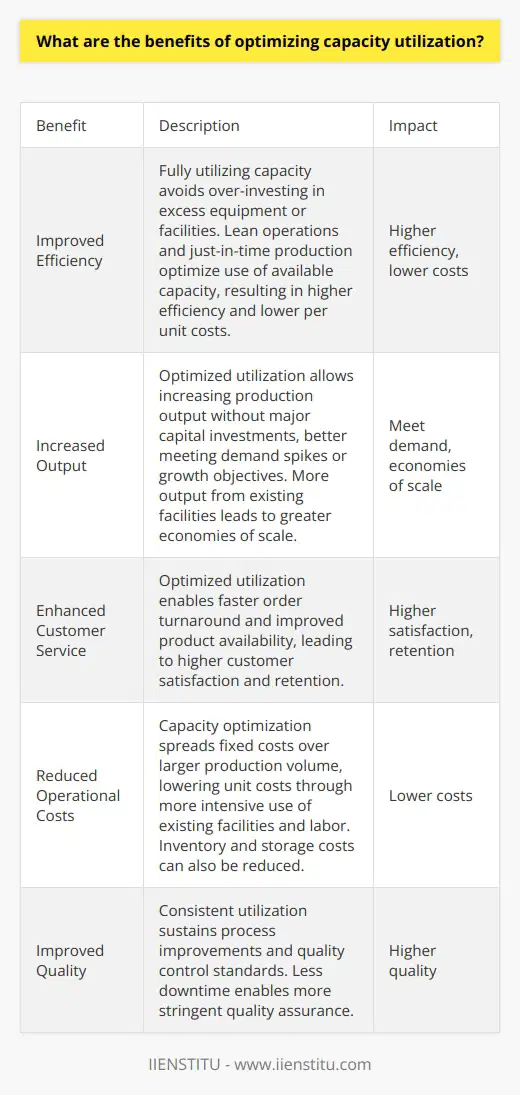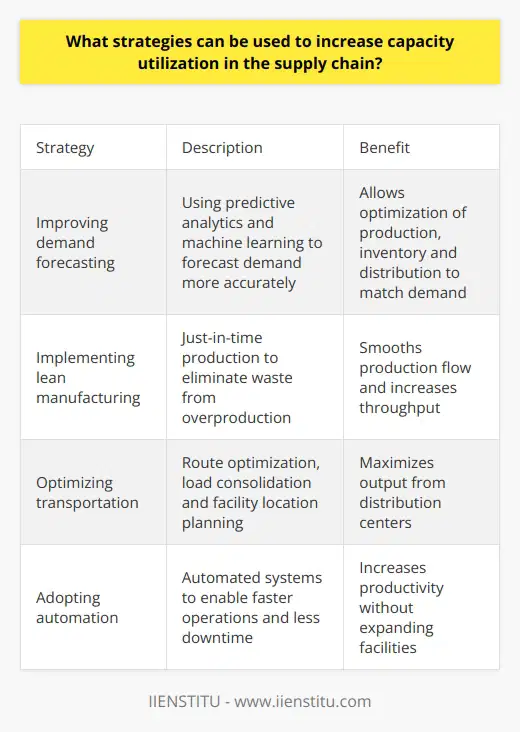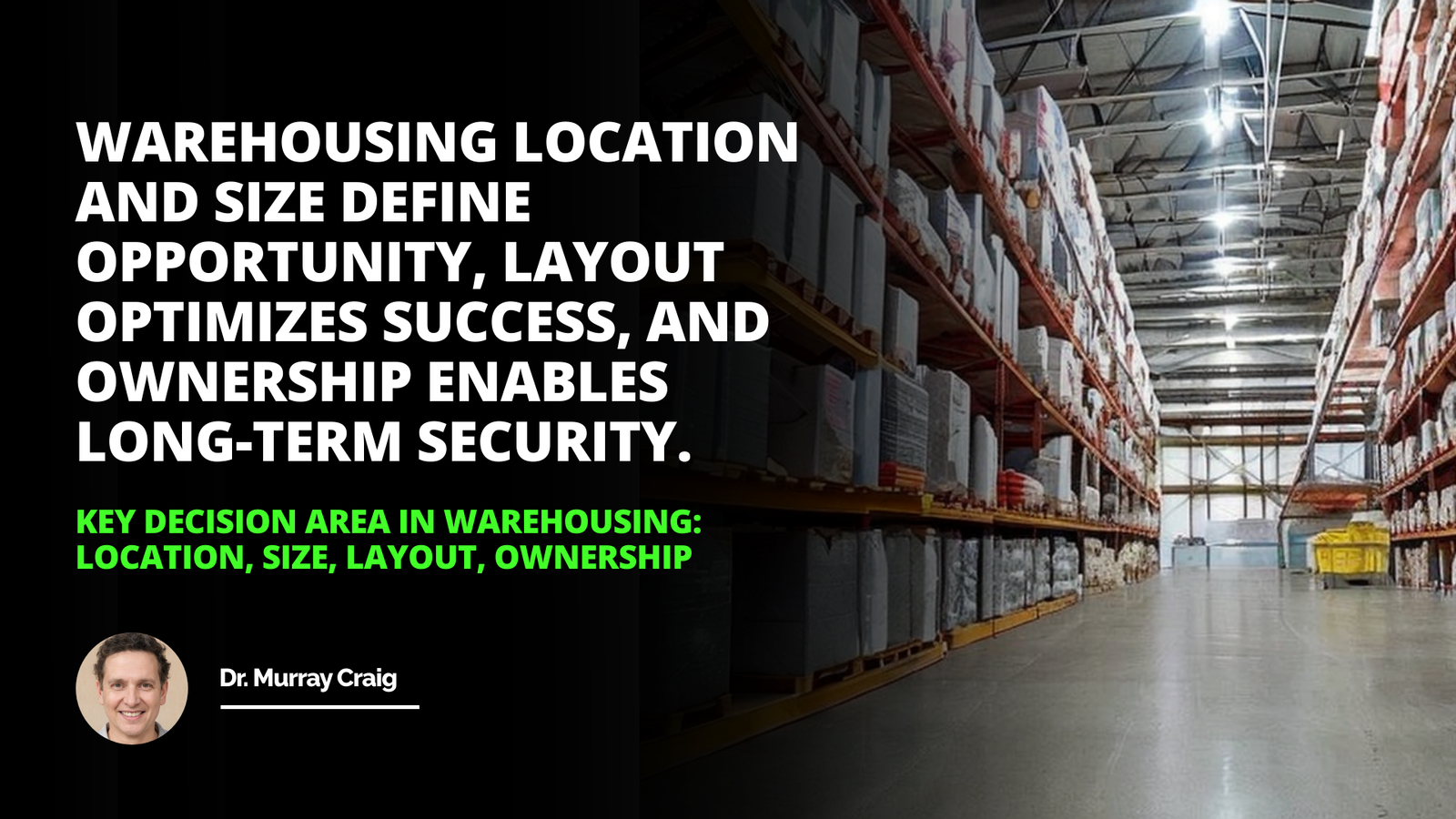
Understanding Capacity Utilization in Supply Chain Management
Definition of Capacity Utilization
Capacity Utilization in Supply Chain Management
Benefits of Optimized Capacity Utilization
Challenges of Implementing Capacity Utilization
Strategies for Achieving Maximum Capacity Utilization
I still remember the time when my friend John, a production manager at a mid-sized manufacturing company, shared his struggles with me over a cup of coffee. He was grappling with inefficient resource use and escalating costs. It wasn't until he delved deep into capacity utilization that he began to turn things around. This concept, often overlooked, became the keystone in optimizing his company's supply chain.
What Exactly is Capacity Utilization?
At its core, capacity utilization is a measure of how effectively a company uses its production resources. Imagine owning a bakery capable of producing 1,000 loaves of bread a day, but only baking 600. That means you're utilizing just 60% of your capacity. The remaining 40% is potential wasted — resources paid for but not used to generate revenue.
In the grander scheme of supply chain management, capacity utilization isn't just about production. It encompasses every facet of the supply chain:
Supplier capabilities
Manufacturing processes
Distribution networks
Inventory management
By keeping a keen eye on capacity utilization across these areas, companies can identify bottlenecks, reduce waste, and improve overall efficiency.
The Importance of Capacity Utilization in Supply Chains
Let's take a moment to consider why capacity utilization holds such significance. In today's fiercely competitive market, operational efficiency isn't just a goal; it's a necessity. Companies that maximize their capacity utilization can:
1- Reduce Operational Costs: By making the most of existing resources, there's less need to invest in additional assets.
2- Enhance Product Delivery Times: Efficient use of capacity often translates to faster production cycles and quicker delivery to customers.
3- Improve Customer Satisfaction: Meeting demand promptly and reliably boosts customer trust and loyalty.
4- Gain Competitive Advantage: Lower costs and better service can set a company apart from its rivals.
Personal Insights: Lessons from the Field
In my early career, I worked with a textile company that struggled with frequent stockouts and excess inventory simultaneously. It was baffling! After some digging, we realized that our production lines weren't aligned with actual market demand — a clear case of poor capacity utilization.
By implementing a more responsive capacity planning system, we managed to align production schedules with real-time demand data. The result? A 15% reduction in holding costs and a significant improvement in our order fulfillment rates.
Challenges in Implementing Effective Capacity Utilization
While the benefits are clear, implementing optimized capacity utilization isn't without its hurdles. Some common challenges include:
Inaccurate Demand Forecasting: If you can't predict demand accurately, adjusting capacity becomes a shot in the dark.
Rigid Production Processes: Outdated systems may lack the flexibility needed to adapt to fluctuating demands.
Limited Visibility Across the Supply Chain: Without a holistic view, inefficiencies in one area can offset gains in another.
Resistance to Change: Employees accustomed to certain processes might resist new methods or technologies.
Strategies to Maximize Capacity Utilization
So, how can companies overcome these challenges? Here are some practical tips to optimize supply chain management processes:
1. Invest in Advanced Planning Systems
Modern Enterprise Resource Planning (ERP) and Advanced Planning and Scheduling (APS) systems can provide real-time data and predictive analytics. These tools help in:
Maximizing capacity utilization is the key to unlocking success in Supply Chain Management.

Accurate Demand Forecasting
Dynamic Capacity Planning
Resource Optimization
For instance, incorporating machine learning algorithms can enhance forecasting accuracy by analyzing historical data and market trends.
2. Implement Lean Manufacturing Principles
Lean methodologies focus on eliminating waste and improving efficiency. Key principles include:
Just-In-Time (JIT) Production: Producing goods only as they are needed, reducing inventory costs.
Continuous Improvement (Kaizen): Encouraging regular, incremental changes to improve processes.
Value Stream Mapping: Visualizing processes to identify and eliminate non-value-adding activities.
3. Enhance Supplier Collaboration
Building strong relationships with suppliers ensures:
Better Coordination: Aligning production schedules and capacity plans.
Improved Flexibility: Quick adjustments to orders based on demand fluctuations.
Shared Risk Management: Collaborating on strategies to mitigate supply chain disruptions.
Once, during a raw material shortage, our close relationship with a key supplier allowed us to secure necessary resources while competitors faced stockouts.
4. Adopt Flexible Manufacturing Systems
Investing in equipment and processes that can be quickly adjusted helps in:
Accommodating Product Variations: Meeting diverse customer needs without significant downtime.
Scaling Production Up or Down: Responding promptly to market demand changes.
5. Train and Empower Employees
An engaged workforce is crucial. By providing training and fostering a culture of ownership, employees can become active participants in optimizing capacity utilization.
Skill Development Programs
Cross-Functional Teams
Incentive Systems for Efficiency Improvements
The Role of Technology in Capacity Utilization
In the age of Industry 4.0, technology plays a pivotal role:
Internet of Things (IoT): Devices provide real-time data on equipment performance and capacity usage.
Artificial Intelligence (AI) and Machine Learning: These enable predictive maintenance and advanced analytics.
Automation and Robotics: Increase production speeds and reduce human error.
For example, using AI algorithms can predict machine failures before they occur, preventing unexpected downtime and maintaining optimal capacity utilization.
Balancing Capacity and Demand: The Art of Forecasting
Accurate demand forecasting is the linchpin of capacity utilization. Techniques include:
1- Quantitative Methods: Utilizing statistical models based on historical data.
2- Qualitative Methods: Incorporating expert opinions and market research.
3- Hybrid Approaches: Combining both for enhanced accuracy.
Tips for Better Forecasting:
Regularly update models with the latest data.
Consider external factors like economic indicators and competitor actions.
Collaborate with sales and marketing teams for ground-level insights.
Overcoming Resistance: Change Management in Capacity Optimization
Implementing new strategies often meets resistance. Effective change management can ease the transition:
Communicate Clearly: Explain the benefits and the need for change.
Involve Stakeholders Early: Get input from those affected to increase buy-in.
Provide Training and Support: Equip teams with the necessary skills.
Measuring Success: Key Performance Indicators (KPIs)
To gauge the effectiveness of capacity utilization strategies, monitor relevant KPIs:
Overall Equipment Effectiveness (OEE)
Production Throughput
Inventory Turnover Ratios
Order Fulfillment Rates
Regularly reviewing these metrics helps in continuous improvement and ensuring that capacity optimization aligns with business goals.
Conclusion: The Path Forward
Maximizing capacity utilization isn't a one-time project; it's an ongoing journey. By understanding its importance and implementing strategic measures, companies can unlock unprecedented levels of efficiency and profitability.
Recalling my friend John's experience, it wasn't magic that turned his situation around. It was a focused effort on understanding and optimizing capacity utilization. He aligned his resources with demand, invested in the right technologies, and nurtured relationships across the supply chain. The transformation was remarkable — not just in numbers but in the renewed confidence of his team.
In today's dynamic market, the companies that thrive are those that leverage every asset to its fullest potential. By dedicating time and resources to capacity utilization, you're not just cutting costs; you're building a resilient, agile, and competitive supply chain.
References
1- Chopra, S., & Meindl, P. (2016). Supply Chain Management: Strategy, Planning, and Operation. Pearson Education.
2- Christopher, M. (2016). Logistics & Supply Chain Management. Pearson UK.
3- Heizer, J., Render, B., & Munson, C. (2017). Operations Management: Sustainability and Supply Chain Management. Pearson.
4- Slack, N., Brandon-Jones, A., & Johnston, R. (2013). Operations Management. Pearson.
5- Goldratt, E. M. (1984). The Goal: A Process of Ongoing Improvement. North River Press.
Optimizing capacity utilization is more than just a strategy; it's a commitment to excellence in every aspect of your operations. Whether you're a small business or a global corporation, these principles can guide you towards greater efficiency and success.
Remember, the journey to optimize supply chain management process tips begins with a single step — understanding the power of capacity utilization.
Frequently Asked Questions
What is capacity utilization in supply chain management?
Capacity utilization is an essential consideration in supply chain management. It refers to the number of resources used to meet customer demand. The higher the capacity utilization, the more efficient the supply chain is, and the lower costs can be achieved. Therefore, capacity utilization can measure how much a company uses its available resources, such as space, labor, and capital.
When applied to supply chain management, capacity utilization helps companies identify areas where resources are not being used efficiently and make changes accordingly. For example, one area has unused capacity but high demand for the product in another. In that case, shifting production or moving materials from one area to another may be beneficial. By doing so, companies can take advantage of existing capacity while meeting customer demand.
Several methods for measuring capacity utilization in supply chain management include inventory turn rate, resource efficiency ratio, and throughput time analysis. Inventory turn rate measures how quickly stock moves through a warehouse or manufacturing facility by calculating the number of times it has been sold over a certain period. The resource efficiency ratio measures how efficiently labor and capital are utilized by dividing total output by total input costs. Finally, throughput time analysis looks at how long it takes from when an order is placed until when it is delivered to customers accounting for production delays or transportation delays caused by weather or other factors.
By understanding how their resources are used, companies can ensure that they continue operating efficiently while meeting customer needs. In addition, analyzing capacity utilization allows companies to plan for future growth, so they stay within their production capabilities and run out of storage space due to increased demand. In summary, capacity utilization provides valuable insights into a company’s supply chain performance, enabling them to make informed decisions when managing its operations and resources.

What are the benefits of optimizing capacity utilization?
Capacity utilization is an essential principle that businesses must consider when attempting to optimize their operations. It refers to the amount of output a business can produce with its given resources, and it can significantly impact the profitability of the business. Optimizing capacity utilization can provide numerous benefits; this article will explore those in greater detail.
One of the key benefits of optimizing capacity utilization is improved efficiency. When a business can maximize its existing resources, it can minimize the resources it uses to produce the same output level. This can lead to significant cost savings in the form of reduced overhead costs and increased profits. Moreover, by increasing efficiency, businesses can increase their production capacity, allowing them to handle larger orders or produce more products.
Another benefit of optimizing capacity utilization is improved customer satisfaction. When businesses can produce more products with the same resources, they can provide faster turnaround times for their customers. This can increase customer loyalty, as customers are more likely to return to businesses that deliver orders quickly and reliably.
Finally, optimizing capacity utilization can also lead to improved quality. When businesses can produce more products with the same resources, they can dedicate more time and resources to ensuring that their products meet the highest quality standards. This can lead to higher customer satisfaction and improved brand reputation, which can, in turn, lead to increased sales.
In conclusion, optimizing capacity utilization can provide numerous benefits to businesses. It can improve efficiency, customer satisfaction, and quality, ultimately increasing profits. For these reasons, businesses must consider capacity utilization when optimizing their operations.

What strategies can be used to increase capacity utilization in the supply chain?
Efficient capacity utilization is a critical element of successful supply chain management. Therefore, companies must ensure that their supply chains are optimized to maximize operations' efficiency and minimize costs. The following strategies can be used to increase capacity utilization in the supply chain:
First, companies should seek out opportunities to improve their inventory management practices. By better understanding customer demand and forecasting product demand more accurately, businesses can reduce inventory levels and free up valuable storage space. Additionally, companies should strive towards implementing lean principles such as Just-in-Time (JIT) production, which reduces waste by producing only what is needed when needed.
Second, companies should improve their transportation networks by optimizing routes and consolidating shipments wherever possible. This can minimize empty backhauls and reduce fuel costs for transporting goods from one location to another. Additionally, partnering with third-party logistics providers can help businesses leverage their collective buying power when negotiating freight rates with carriers.
Third, companies should focus on improving their scheduling practices. Utilizing advanced planning systems such as material requirements planning (MRP) or enterprise resource planning (ERP) can help businesses better manage resources and optimize production schedules based on customer demand forecasts. This will enable them to maximize capacity utilization while minimizing labor costs associated with scheduling activities.
Finally, companies should consider investing in automation technologies such as robotics or artificial intelligence (AI). Automation technologies can streamline processes and reduce manual labor costs while increasing throughput levels and reducing errors associated with manual processes. Additionally, these technologies can enable businesses to increase capacity utilization without investing in additional physical infrastructure or personnel resources due to improved productivity levels associated with automation systems.
In conclusion, there are several strategies that businesses can use to increase capacity utilization in the supply chain, including improving inventory management practices, optimizing transportation networks, implementing scheduling optimization techniques, and investing in automation technologies. By utilizing these strategies, organizations can achieve greater efficiency across their operations, thereby reducing operating costs and increasing customer satisfaction.



